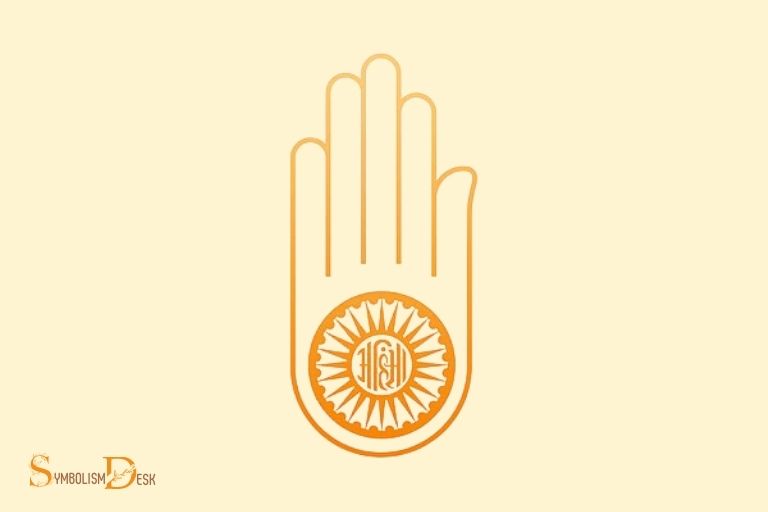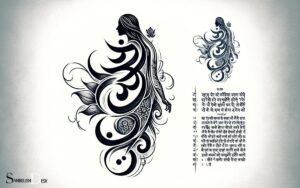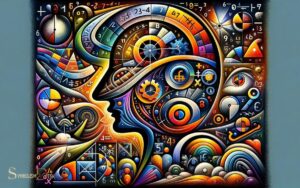What Does the Jainism Symbol Mean? Jain Prateek Chihna!
The Jainism symbol, also known as the Jain Prateek Chihna, is a depiction of the religion’s main beliefs and principles.
It comprises of a swastika, a hand with a wheel on the palm, three dots above the swastika, a crescent, and a dot. Each component of the symbol carries significant meaning.
For instance, the swastika signifies the cycle of birth and rebirth while the three dots represent the three jewels of Jainism – right faith, right knowledge, and right conduct.
Jainism symbol is a comprehensive representation of the teachings and ideologies of Jainism. The hand in the symbol signifies non-violence, indicating that one should stop violence.
The wheel in the palm, known as the ‘Dharmachakra’, represents the Jain doctrine’s continuous cycle. The three dots, as mentioned, symbolize the Jain’s three guiding principles. The crescent with a dot signifies the abode of the liberated souls.
In summary, the Jainism symbol encapsulates key Jainism principles, which guide its followers’ lives. It is a graphic expression of non-violence, respect for
6 Symbols About the Meanings of Jainism
| Symbol | Meaning |
|---|---|
| Swastika | Represents the four states of existence: heavenly beings, human benefits, hellish being, and flora or fauna. It also represents the cycle of birth and death. |
| Three Dots | Represents the three jewels of Jainism: right belief, right knowledge, and right conduct. |
| Hand with a Wheel | The hand symbolizes ahimsa (non-violence) and the wheel in the palm represents the dharmachakra (wheel of law), signifying the resolve to halt the cycle of reincarnation through constant pursuit of truth. |
| Outline of the Universe | The large brackets on either side of the symbols represent the upper and lower portions of the universe, separated by the middle universe where humans reside. |
| Rising Sun | Represents the path to enlightenment and liberation. |
| Moon | Symbolizes the practitioners who achieve liberation from the cycle of rebirth and death. |
Key Takeaway

Five Facts About: The Jainism Symbol
What Is Jainism And Its Origins?
Jainism, one of the oldest religions in the world, is a philosophy and way of life originating in ancient india. Some scholars consider it a branch of hinduism, while others see it as an independent religion.
Today, it has over four million followers, mostly in india but also around the world, including in europe and north america.
Brief history of jainism jainism is believed to have originated in the 6th century bce and was founded by mahavira, also known as vardhamana, who was a contemporary of buddha and lived in the same region.
Jainism spread throughout india and beyond in the following centuries, but it faced persecution by other religions including hinduism and islam, particularly during the medieval period.
Despite this, jainism survived and continued to flourish until today.
Fundamental teachings and principles of jainism jainism is based on three main principles: ahimsa, which means nonviolence; anekantavada, which means multiplicity of perspectives; and aparigraha, which means nonattachment to material possessions.
These principles are reflected in the practices and values of jainism, including vegetarianism, meditation, and charity.
Jains believe in the existence of countless souls, both human and non-human, that have the potential to achieve enlightenment and liberation.
To attain this, jains follow a strict ethical and spiritual code that involves avoiding harm to any living beings, practicing self-discipline, and striving for spiritual purity.
overview of jainism’s symbol and its significance the jainism symbol consists of three main elements:
A hand with a wheel on the palm, a swastika, and an om. The hand represents the jain vow of ahimsa, which emphasizes the importance of nonviolence towards all living beings.
The wheel represents the samsara, the cycle of birth, death, and rebirth, which jains seek to escape by following the ethical code and achieving spiritual purity.
The swastika represents the four realms of existence: human, heavenly, hellish, and animal, and the four gati, or destinies, that living beings can take.
The om represents the spiritual realm and the ultimate goal of jainism, which is to achieve enlightenment and liberation.
Overall, the jainism symbol represents the core values and teachings of jainism, and serves as a reminder of the importance of nonviolence, ethical conduct, and spiritual purity in daily life.
What Is The Jainism Symbol?
The jainism religion is one of the oldest in india, dating back over 2,500 years. It is a highly philosophical faith that emphasizes non-violence, simple living, and the liberation of the soul.
The jainism symbol, also known as the jain emblem, is an essential part of the jainism religion.
It contains several significant elements that hold great meaning to the jain community.
In this section, we will discuss what the jainism symbol represents and its significance to the jain community. We will cover three key subtopics under the h3 headings.
Make sure to use markdown format and adhere to the guidelines for optimum seo value.
The Symbol Of Jainism In Detail
The jainism symbol consists of three major components, namely:
Supreme beings tirthankaras sitting in padmasana on a throne. They are the 24 coaches of jainism, which are known as arhats. According to jainism, the arhat is an individual who attained enlightenment and freed themselves from the cycle of birth and death.
The hand with a wheel on the palm is known as vardhamanaka dhvaja. It signifies the jain universal law of preaching or dharma, which is driven by the wheel of time.
The three dots on the top symbolize the jain philosophy of ahimsa, anekantvad, and aparigraha. Ahimsa means non-violence, anekantvad refers to the many aspects of reality, and aparigraha means non-attachment to material possessions.
The Meaning Behind The Swastika And Its Representation In The Jainism Symbol
Jainism symbol includes the swastika, which is an ancient indian symbol of good luck and well-being. It must be remembered that the swastika was here first and existed in india way before the usage in nazi times. The swastika in Jainism represents peace, prosperity, and spiritual progression, carrying a completely different connotation from its later appropriation. The nazi symbol meaning in India is, therefore, starkly distinct and carries no association with the original cultural and religious significance of the swastika. It is important to view the Jain usage within its historical and spiritual framework, separate from the negative implications the symbol gained during the 20th century.
The swastika in the jainism symbol represents:
- The four states of existence, which are humans, animals, heavenly beings, and hellish beings, in which souls can take birth.
- The four types of birth, namely, the egg, womb, sweat-born, and spontaneous generation.
- The four stages of an ascetic’s life – monk, nun, layman, and laywomen.
The Significance Of The 24 Spokes And Their Representation In The Jainism Symbol
The 24 spokes in the jainism symbol represent the 24 coaches of jainism, also known as tirthankaras. These coaches paved the way for living a morally justified and wholesome life.
The twenty-four tirthankaras are:
- Rishabhanatha
- Ajitanatha
- Sambhavanatha
- Abhinandananatha
- Sumatinatha
- Padmaprabha
- Suparshvanatha
- Chandraprabha
- Pushpadanta
- Sheetalanatha
- Shreyanasanatha
- Vasupujya
- Vimalanatha
- Anantnatha
- Dharmanatha
- Shantinatha
- Kunthunatha
- Aranatha
- Mallinatha
- Munisuvrata
- Naminatha
- Neminatha
- Parshvanatha
- Mahavira
Each spoke also signifies several virtues, including right faith, perception, knowledge, conduct, penance, equanimity, and non-attachment.
The jainism symbol is one of the most intricate and meaningful in indian religion. It represents not only the jain community’s beliefs but also their hope and faith in living life morally.
Understanding the significance of each component can help people to appreciate its beauty and the deep-seated principles that make up the jainism religion.
The Jainism Symbol Explained
Jainism is a religion that originated in india over 2,500 years ago. The jainism symbol, also known as the jain emblem, is an important representation of this religion.
The symbol consists of three main parts – three dots, a crescent, and a swastika.
Let’s take a closer look at the interpretation of the jainism symbol, explaining the meaning behind each element and what it represents for followers of this religion.
Interpretation Of The Jainism Symbol
- The jainism symbol represents the path to eternal happiness (moksha) which can be achieved by following the principles of jainism.
- The three dots, crescent, and swastika work together to symbolize the three jewels of jainism; right faith (samyak darshan), right knowledge (samyak gyana), and right conduct (samyak charitra).
Explanation Of The Three Dots, Crescent, And Swastika
Three dots: The three dots represent the three jewels of jainism. They are placed on the top of the symbol, signifying the importance of these principles in jainism.
The dots also represent the three types of people who follow this religion – monks, nuns, and śrāvaka (laymen).
Crescent: Located in the middle of the symbol, the crescent represents non-attachment to worldly belongings, one of the significant principles of jainism.
The shape of crescent represents the constant ‘crescent moon’ during the fasting of the jain monks, reflecting the superior asceticism, which is essential in jainism.
Swastika: Known in jainism as the swastika, this symbol faces in all four directions and represents the four states of existence – humans, gods, hell, and animals.
It also signifies the four principles of jainism – ahimsa (non-violence), satya (truth), asteya (non-stealing), and brahmacharya (celibacy).
Insight Into What The Jainism Symbol Represents
- The jainism symbol represents the core principles of jainism, which include non-violence, truth, non-stealing, celibacy, non-possession, and non-attachment to worldly things.
- It serves as a reminder to followers of the path to true happiness, which can be achieved by following the teachings of jainism and following the path of dharma.
- The symbol also represents the three jewels of jainism (right faith, right knowledge, and right conduct) and the importance of these principles in achieving moksha (eternal happiness).
The jainism symbol is an essential representation of this ancient religion. It serves as a reminder of the core values and principles of jainism and represents the path to eternal happiness by following the guidelines of jainism.
Understanding its interpretation and meaning can deepen our knowledge of jainism and inspire us to practice the path of dharma.
Jainism Symbol: Historical And Symbolic Significance
Jainism is an ancient religion that dates back to the 6th century bce. The jainism symbol, also known as the jain emblem, is a depiction of many fundamental concepts and principles of the religion.
It comprises three main elements: a hand with a wheel on the palm, a swastika, and three dots above the apex of the swastika.
The jainism symbol is usually placed at the entrance of a jain temple or on important religious and cultural items.
Examination Of Historical And Cultural Significance Of The Jainism Symbol
The jainism symbol is an essential element of the jain religion and reflects its history and culture.
The following are some of the historical and cultural significances of the jainism symbol:
The hand with a wheel on the palm represents ahimsa, non-violence. It reminds jains to avoid harming others and living beings, and to take care of them instead.
The wheel indicates the cycle of birth, death, and rebirth, which jains believe can only be broken by following the path of spiritual liberation.
The swastika is a symbol of good luck and peace. It represents the continuing cycle of birth and reincarnation.
Jains believe that every soul is on a journey towards liberation or moksha, and the swastika represents the cycles of birth and rebirth until one reaches moksha.
The three dots above the apex of the swastika symbolize the three jewels of jainism: Right belief, right knowledge, and right conduct. Jainism teaches that the three jewels should be the focus of one’s life, and by following them, an individual can eventually achieve liberation.
The Portrayal Of The Jainism Symbol In Ancient Scriptures And Relics
The jainism symbol has been depicted in various ancient scriptures and relics.
Some of the prominent depictions are:
In jain literature and mythology, the symbol is associated with lord mahavira, the last of the tirthankaras (spiritual teachers) of jainism. It is believed that lord mahavira had 14 auspicious dreams before his birth, and one of them was a hand with a wheel engraved on it.
The symbol can be found in various jain temples, sculptures, and paintings. The most famous of them is the jain temple at ranakpur, which has the jainism symbol engraved in the marble walls.
Interpreting The Jainism Symbol In A Modern Context
In a modern context, the jainism symbol still holds relevance and significance.
The following are some of the modern interpretations of the jainism symbol:
- In today’s world, where violence is prevalent, the hand with a wheel on the palm represents the need for non-violence, compassion, and love towards all living beings.
- The swastika’s interpretation has changed over the years, and it is no longer seen as just a symbol of good luck and peace. Today, it is also a symbol of oppression and hatred due to its association with nazi germany. However, jains still use the symbol in its original context, representing the continuing cycle of birth, death, and rebirth towards liberation.
- The three dots above the apex of the swastika are a reminder of the three essential principles of jainism, which are essential in leading a fulfilling and purposeful life.
The jainism symbol has a rich history and cultural significance. It is a reminder of the principles of jainism and the need for compassion, non-violence, and love towards all living beings.
The jainism symbol is more than just a symbol; it is a representation of the jain way of life.
What is the Meaning Behind the Jagermeister Symbol?
The jagermeister symbol meaning explained the iconic emblem of Jagermeister holds depth and significance. Rooted in German folklore, it depicts a stag with a cross between its antlers. Symbolizing the fusion of nature and spirituality, it represents the harmony between humans and the natural world. Additionally, the cross represents protection and the pursuit of higher values, while the stag embodies strength and grace.
FAQ About What Does The Jainism Symbol Mean?
What Is The Jainism Symbol?
The jainism symbol, a hand with a wheel on its palm, represents the jain path to enlightenment.
What Is The Meaning Of The Hand In The Jainism Symbol?
The hand in the jainism symbol represents ahimsa, non-violence, one of the fundamental principles of jainism.
What Does The Wheel In The Jainism Symbol Represent?
The wheel in the jainism symbol represents the cycle of birth, death, and rebirth, which is central to jain philosophy.
What Is The Significance Of Three Dots Above The Jainism Symbol?
The three dots above the jainism symbol represent the three jewels of jainism: right faith, right knowledge, and right conduct.
What Are The Core Principles Of Jainism Represented In The Jainism Symbol?
The core principles of jainism represented in the jainism symbol include non-violence, non-attachment, and self-discipline.
Conclusion
Jainism symbol, also known as jain emblem, portrays the essence of the jain religion.
The symbol consists of three important components— the hand with a wheel, a swastika, and an outline of three dots above and below. Each element of the symbol has a deep significance and represents different aspects of the jain philosophy.
The hand with a wheel represents the jain concept of ahimsa or non-violence.
The swastika represents the cycle of birth, life, and death, and the three dots above and below represent the three jewels of jainism- right faith, right knowledge, and right conduct.
Understanding the jainism symbol and its significance is crucial in comprehending the basic principles of jainism.
The emblem serves as a reminder for followers to lead a path of non-violence and compassion towards all living beings. It signifies the importance of detaching oneself from worldly desires and achieving inner peace.
This emblem serves as an inspirational symbol of peace and harmony for everyone, no matter what religion one may follow.






